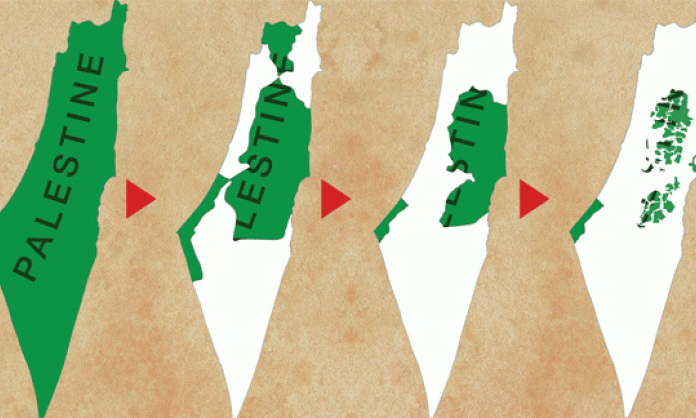The conflict between Palestine and Israel is sometimes described as an ancient, unsolvable religious conflict fuelled by a perpetual cycle of violence and revenge. At other times it is described as a David versus Goliath struggle where “underdog” Israel tries to survive amidst a sea of terrorist Arabs.
Yet the origins of the Israel-Palestine conflict do not date back to time immemorial. The conflict began with Zionist colonisation last century and the mass expulsion of Palestinians when the state of Israel was formed in 1948. It is not a conflict about religion, but about land.
Israel is no underdog. It is an imperialist power in its own right. The country’s air force is a quarter of the size of the US air force; its overall conventional military might is estimated by think tank Global Firepower to be 11th largest in the world.
In addition to this extremely strong conventional army, Israel is one of nine countries to have nuclear weapons. Its stockpile is estimated to be more than 100 bombs.
The US-Israel relationship
Its relationship to the big imperialist powers was spelled out by Israeli newspaper Ha’aretz in 1951: “[S]trengthening Israel helps the Western powers maintain equilibrium and stability in the Middle East. Israel is to become the watchdog.
“There is no fear that Israel will undertake any aggressive policy towards the Arab states when this would explicitly contradict the wishes of the US and Britain. But if for any reason the Western powers should sometimes prefer to close their eyes, Israel could be relied upon to punish one or several neighbouring states whose discourtesy to the West went beyond the bounds of the permissible.”
In exchange for acting as the West’s regional enforcer, Israel gets substantial military aid – currently $3 billion per year from the US government – access to military technology, and political and diplomatic support. Israel is a Goliath, not a David. The only other states in the region with conventional military power close to Israel’s are Turkey and Egypt, neither of which have nuclear weapons.
Palestine’s history
For well over 1,000 years before the formation of the Israeli state, Palestine had been inhabited by a Muslim majority and a Jewish minority who lived together largely in peace. When the Crusades brought rampaging Christians to Jerusalem in 1099, Jews and Muslims fought and died together defending the city.
Due to the rising popularity of Zionism (a political ideology that argues that Jews and non-Jews cannot live together in peace, and that Jews therefore need to establish their own country), the 20th century brought increasing Jewish migration to Palestine. Notorious British anti-Semitic politician Lord Arthur Balfour saw an opportunity in the Zionist cause to get Jews to leave England and to use them as colonists for the British Empire. In 1917 came the Balfour Declaration, which pledged a degree of British support to the Zionist project.
The 1947 United Nations partition plan for Palestine was a turning point in the dispossession of the Palestinians. Historic Palestine was divided into two states – a Palestinian state comprising 43 percent of the land, an Israeli state with 56 percent and Jerusalem as a shared capital. Prior to the partition, Jewish ownership of land in Palestine was around 6 percent and the Jewish population was estimated at 30 percent.
This wide-scale theft of land by Zionists led to rebellion and war. Zionist militias carried out massacres aimed at terrorising the Palestinian population into fleeing.
On 9 April 1948, members of the Irgun, a Zionist terrorist militia, assaulted the village of Deir Yassin. At the end of the attack, Jacques de Reynier, an International Red Cross observer, declared:
“The first room was dark, everything was in disorder, but there was no-one. In the second, amid disembowelled furniture and all sorts of debris, I found some bodies cold. Here the cleaning up had been done with machine guns, then hand grenades. It had been finished off with knives, anyone could see that.
“The same thing in the next room but as I was about to leave, I heard something like a sigh. I looked everywhere, turned over all the bodies, and eventually found a little foot, still warm. It was a little girl of ten, mutilated by a hand grenade, but still alive; everywhere it was the same horrible sight … there had been 400 people in this village; about fifty had escaped.
“All the rest had been deliberately massacred in cold blood for, as I observed for myself, this gang was admirably disciplined and acted only under orders.”
This wave of terror and ethnic cleansing of Palestinians is referred to as al-Nakba – the catastrophe. In Israel, it is celebrated as Independence Day. For more than 60 years, the Palestinians ethnically cleansed and their descendants have not been able to return.
Since its foundation, Israel has been fiercely expansionist. In 1967, in the space of six days, it seized what remained of Palestine, occupying the Gaza Strip and West Bank as well as parts of Syria and Egypt. This Six Day War proved to the United States how powerful an ally Israel could become. The loss of Iran as an ally after the 1979 revolution cemented the Zionist state as America’s key ally in the region.
What would a real solution look like?
Many have argued for a return to the pre-1967 borders and the creation of a Palestinian state alongside the existing Israeli state. This would offer nothing to those expelled during al-Nakba. Events today prove that such a Palestinian state would forever be insecure with such a powerful, well-armed and expansionist neighbour.
The only just solution in Palestine is to have one democratic state that offers equal rights for Arabs and Jews, and the right for Palestinian refugees to return to their homeland. Achieving this “one state solution” would require dismantling the racist apartheid state of Israel and breaking the power of US imperialism in the region.
It’s no small task. But it is the only way justice can be served.











